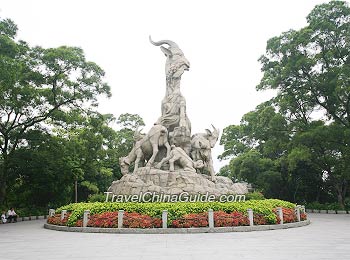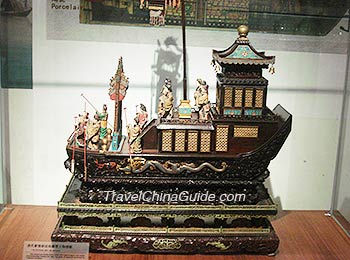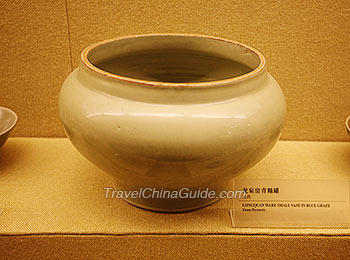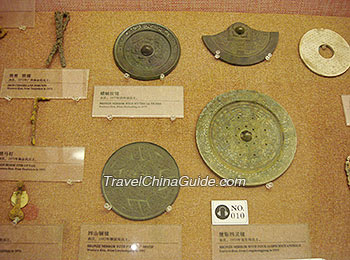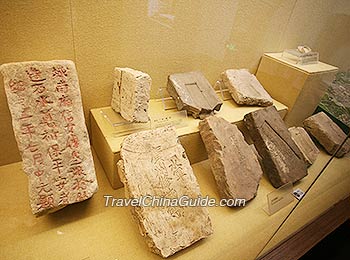According to historical records, Chuting was the earliest formation of present Guangzhou. It has been 2,800 years since the Chuting was first used when Chu State of the Zhou Dynasty (11th Century BC - 221BC) sent ministers there to make it submitted to Chu.
Legend on the Ram City
There had been successions of famine and crop failure in Chuting during the Zhou Dynasty. One day, five colorful auspicious clouds drifted from the South Sea, conveying five celestial beings on five celestial rams. They blessed people with ears of rice in a sheep's mouth. The five celestial beings left but the five rams stayed in Chuting, continuing to protect local people and prayed for favorable weather and a good harvest. To honor the fairies, people built 'Wuxian Guan', a Taoist temple with their sculptures, accompanied by a stone statue of the rams. Hence, the city is also known as the 'Ram City' (Yang Cheng) or 'Rice Ears City' (Sui Cheng).
The City of Guangzhou
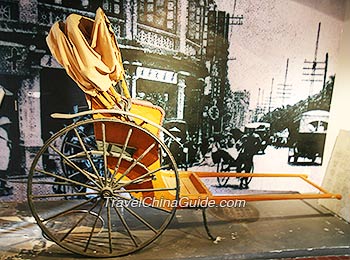 |
| Popular Rickshaw in the old times |
When was Guangzhou established? The Qin Dynasty (221BC - 206BC) conquered Lingnan Region and established three shires. Nanhai Shire included most of Guangdong Province with Fanyu, with the present Guangzhou as the capital. The site of the small city is located around Jiucang Xiang of Cangbian Lu in the present Guangzhou. Zhaolun took over Nanhai Shire in the early Han dynasty, which absorbed the surrounding area. Then Nanyue Kingdom was established and expanded into the city.
The city walls of Guangzhou were restored a dozen of times in the Song Dynasty (960 - 1279). Middle, east and west cities were built in succession. The Ming Court (1368-1644) brought the three cities together and called them the Old City, and constructed a new one in the south, through the second expansion project in late Ming.
Is Guangzhou and Guangdong the same? The answer is No. Nowadays, Guangzhou, the provincial capital of Guangdong Province, located in south-central Guangdong.
Main Port of the Maritime Silk Road
The city has always been the political, economic and culture center of South China for more than 2,000 years. In its early years, it was a distribution center of rare tropical products.
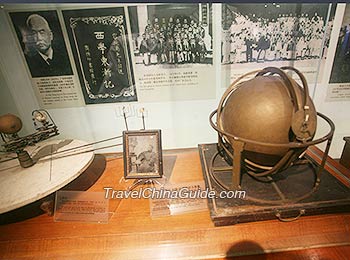 |
| Historical relics show the marine history |
In the Han Dynasty (206BC-220AD), Fanyu had developed commerce and advanced textile and porcelain industries and foreign exchange with overseas, using this place as a vital port. During the Tang Dynasty (618-907), it has become a world famous trading harbor with countries in the South Pacific Ocean and the Indian Ocean. To strengthen the foreign trade, China's earliest customs was set up there. It grew rapidly and became the largest commercial city and treaty port in China.
Since early 3rd century, it has replaced Xuwen (in Zhanjiang City) and Hepu (in Beihai City) ports, ascending the throne as the main port of the Maritime Silk Road which initiated during Qin and Han dynasties until Quanzhou overshadowed it from late Song to Yuan (1279 - 1368). However, it recovered and was the only open port under the policy of isolation in the Qing Dynasty (1644-1911).
Guangzhou and Lingnan Culture
The word 'Lingnan' comes from the Eastern Zhou Dynasty (770BC-221BC), generally referring to Guangdong, Guangxi and the north of Vietnam. The nationality here was called Nanyue. In terms of geography, Lingnan Culture can be divided into three cultural branches in the Pearl River Drainage Area, Guangxi and Hainan. Guangzhou is the center of Cantonese culture along the Pearl River and the most outstanding of Lingnan Culture. The Cantonese dialect, Cantonese Opera, Lingnan calligraphy, art schools, architecture, miniascape, Cantonese cuisine, as well as music and handicrafts are all included in its scope.
In terms of the essence, aboriginal culture of Nanyue ethnic group, the ocean and the culture from Central China are major elements of Lingnan Culture. The local people prefer morning tea with dim sum. In addition, the city is representative of Lingnan architecture. Academy building ancestral temple of Ming and Qing dynasties, Xiguan Dawu (Xiguan Residential House) and Qilou Building (Arcade Building) of late Qing are all typical Lingnan style architecture, built in consideration of the climate and geography in the Lingnan Area.
- Last updated on Apr. 15, 2021 -
